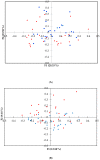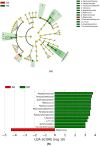Gut Microbiome of Healthy and Arthritic Dogs
- PMID: 32674496
- PMCID: PMC7558702
- DOI: 10.3390/vetsci7030092
Gut Microbiome of Healthy and Arthritic Dogs
Abstract
Several studies have underlined the interplay among host-microbiome and pathophysiological conditions of animals. Research has also focused specifically on whether and how changes in the gut microbiome have provoked the occurrence of pathological phenomena affecting cartilage and joints in humans and in laboratory animals. Here, we tried to evaluate the relationship between the gut microbiome and the hip and elbow arthritis in owned dogs. The study included 14 dogs suffering from chronic arthritis (AD) and 13 healthy dogs (HD). After the first visit and during the period of the study, the dogs, under the supervision of the owner, were fed a semi-moist complete diet supplemented with omega 3 fatty acids. Feces and blood samples were collected in the clinic at the first visit (T0) and after days (T45). The plasma C-reactive protein (CRP) was higher, and the serum vitamin B12 and folate concentrations were lower (p < 0.05) in the AD group in comparison to the HD group. Data of the fecal microbiome showed that the relative abundances of the genus Megamonas were higher in AD (p < 0.001), while the relative abundance of the families Paraprevotellaceae, Porphyromonadaceae, and Mogibacteriaceae was significantly lower in comparison to HD. The results of the study identified several bacterial groups that differed significantly in the fecal microbiome between healthy and diseased dogs. If the observed differences in fecal bacterial composition predispose dogs to hip and elbow arthritis or if these differences reflect a correlation with these conditions deserves further investigation.
Keywords: arthritis; dogs; gut microbiome; hematological parameters.
Conflict of interest statement
The authors declare no conflict of interest.
Figures



References
-
- Suchodolski J.S., Markel M.E., Garcia-Mazcorro J.F., Unterer S., Heilmann R.M., Dowd S.E., Kachroo P., Ivanov I., Minamoto Y., Dillman E.M., et al. The fecal microbiome in dogs with acute diarrhea and idiopathic inflammatory bowel disease. PLoS ONE. 2012;7:e51907. doi: 10.1371/journal.pone.0051907. - DOI - PMC - PubMed
Grants and funding
LinkOut - more resources
Full Text Sources
Research Materials
Miscellaneous

